Pass Cisco 300-515 PDF Dumps Recently Updated 72 Questions [Q39-Q57]

Pass Cisco 300-515 PDF Dumps | Recently Updated 72 Questions
Updated Test Engine to Practice 300-515 Dumps & Practice Exam
Conclusion
With key concepts and skills regarding networking and core technologies about the Service Provider, beginning your training and preparation for the Cisco 300-515 exam would be easier. With a commitment to the exam subject matter, you should manage the whole procedure including passing the final validation itself. The skills from such a test and the CCNP Service Provider certificate are ideal for great roles in networking that are always in demand. So, even as you prepare, keep reflecting on what awaits you!
Topics of Implementing Cisco Service Provider VPN Services (300-515 SPVI) Exam
These core topics isted below are general recommendations for the material that is likely to be used for the examination. However, on any particular delivery of the test, other similar topics could also appear. The guidelines below can update at any time without notice to better represent the contents of the exam and for clarity purposes.
It is recommended that, where possible, the applicant use these courses and/or other resources to provide background information on the exam objectives. The syllabus for the Implementing Cisco Service Provider VPN Services (300-515 SPVI) examination is listed below in detail of each section and their topics:
1. VPN Architecture (25%)
Objectives covered by this section:
Objective 1.1 – Compare VPN architecture:
- Inter-AS and Intra-AS
- Layer 2 and Layer 3 VPN
Objective 1.2 – Troubleshoot underlay:
- Core IGP
- LSP
Objective 1.3 – Describe Layer 2 service architecture:
- IOS XR Ethernet Flowpoints
- IOS XE Ethernet Virtual Circuits
Objective 1.4 – Describe the L3VPN control plane operation:
- PE-CE route advertisement
- VPNv4 address
- MP-BGP
- Route target
- Route distinguisher
Objective 1.5 – Describe the L3VPN data plane operation:
- Underlay label
- VRF forwarding instance
2. Layer 2 VPNs (30%)
Objectives covered by this section:
Objective 2.1 – Troubleshoot L2VPN Services:
- E-Tree
- E-Line
- E-LAN
Objective 2.2 – Describe EVPN concepts:
- Traffic forwarding operation
- Data plane and control plane operation
- Multihoming mechanisms
- Suppression mechanisms
Objective 2.3 – Implement Ethernet Operations, Administration, and Maintenance (E-OAM)
Objective 2.4 – Implementing EVPN:
- EVPN VPWS
- EVPN native
- EVPN IRB
3. Layer 3 VPNs (35%)
Objectives covered by this section:
Objective 3.1 – Describe routing requirements:
- PE-CE routing protocol
- MP-BGP
Objective 3.2 – Troubleshoot Intra-AS L3VPNs:
- PE-PE
- PE-CE
- PE-RR
Objective 3.3 – Implement multicast VPN:
- MLDP
- Extranet MVPN
- Intranet MVPN
Objective 3.4 – Implement extranet/shared services:
- Route policy
- Import and export route targets
Objective 3.5 – Describe Inter-AS L3VPNs:
- Option AB
- Option B
- Option C
- Option A
Objective 3.6 – Describe CSC concepts:
4. IPv6 VPNs (10%)
Objectives covered by this section:
Objective 4.1 – Describe routing requirements:
- MP-BGP
- PE-CE routing protocol
Objective 4.2 – Troubleshoot IPv6 VPN provider edge:
- PE-PE
- PE-CE
Cisco 300-515 Dumps Cover Real Exam Questions: https://www.topexamcollection.com/300-515-vce-collection.html





